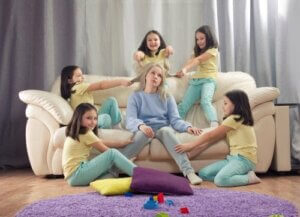Restless Children vs. Hyperactive Children


Written and verified by the psychologist Mara Amor López
Restless children or hyperactive children? Without a doubt, if your child is full of energy and never sits still, you’ve asked yourself this question. In reality, it’s something that worries us as parents, especially when children begin school and we receive complaints from teachers because they’re so restless.
Every day, more and more small children are diagnosed as hyperactive. At an early age, it’s very difficult to make a diagnosis that may label children for the rest of their lives.
Therefore, it’s important to be very careful. Of course, it’s true that some of these children may actually be hyperactive. However, there are also many of them that simply have a great deal of energy and need to move.
Restless children vs. hyperactive children
On many occasions, as parents, we observe that our children, from an early age, have a hard time sitting still. They’re very dynamic and love to investigate and discover new things. As a result, they spend very little time sitting down.
When these kids go to school, the first thing the teacher says is: “He’s a really active kid, he might have ADHD (Attention Deficit Hyperactivity Disorder). We’re going to refer him to a specialist…”
But is it really fair to say that a 3-year-old who’s just started preschool is hyperactive? We don’t think so. There are many specialists who claim that children shouldn’t receive a diagnosis of ADHD until at least second grade (around 7 or 8 years of age). This is when their evaluation can begin.

If we label children as hyperactive from the time they’re very young, this will follow them throughout their entire academic life. What’s more, it can affect their self-esteem and personality in a negative way. Perhaps many of these children just need to experiment, touch, move, etc.
Every child is different
There will always be children that have the constant need to move. But that doesn’t necessarily mean that they’re hyperactive. Today, there’s a major tendency to label children early on and prescribe medications right away.
Every child is different and, normally, we only worry when their behavior starts to cause problems. There are some children that have a hard time relating to others but they live with their noses in a book… And there are other children that have learning difficulties but who never cause problems in class.
In both of these cases, it’s clear that these children have emotional problems, but we hesitate to label them. However, when children have a hard time sitting still, or possess characteristics that cause problems in class, they’re more likely to be labeled prematurely.
What’s more, on many occasions, children start receiving medication before they even receive a trustworthy diagnosis. In short, it’s because it gets them to behave better in class.
Restless children vs. hyperactive children: Solutions
Below, we want to suggest some solutions you can keep in mind when it comes to keeping little ones from being labeled as hyperactive children.
Attention to diversity at school
Not all children are the same, and there’s no reason that should be a problem. From this standpoint, it’s important to note the need that little ones have to touch, move, and experiment with their hands. This helps us understand how hard it is for them to sit still for long periods of time. What’s more, if schools place importance on diversity, then they should take this into consideration.
Pharmacological therapy
From a physiological standpoint, we have a medication that helps these children control their impulses. However, we often medicate in cases that don’t actually involve ADHD. It’s important to be careful and wait for a specialist to make an evaluation at the proper time.
The importance of psychological attention
There are more and more families and educators that request treatment for restlessness, keeping in mind that it can have a psychological origin and treatment. Some causes may include the following:
- A lack of the stimuli that facilitate the parent-child bond at an early age.
- An excess of artificial stimuli, such as television, cell phones, videogames, tablets, etc.

Healthy eating
Many nutritionists have indicated that an excess of refined sugars and chemical additives can produce excitability in children.
Tend to their needs
We need to keep in mind each child’s individual nature, needs and desires. And, of course, we need to establish certain limits and norms, without being overly strict.
At home, we can work with children on activities related to touch… Touching water, mud, paint, etc. What’s more, we can establish an area where children can burn off energy by moving, jumping and running.
Facilitate the expression of their emotions
Let children express their emotions and tell you how they feel. What’s more, give them plenty of hugs and affection.
Conclusions regarding restless children vs. hyperactive children
As you can see, this is a delicate issue. There are some children who receive a diagnosis and medication for ADHD that don’t actually have this disorder. What’s more, labelling children at such a young age doesn’t do them any favors.
As parents, we need to put off any diagnosis of ADHD until our children are at least seven or eight years old. Before this time, it’s impossible to make a complete evaluation. In smaller children, an excess of movement is often due to a simple lack of cognitive maturity.
Restless children or hyperactive children? Without a doubt, if your child is full of energy and never sits still, you’ve asked yourself this question. In reality, it’s something that worries us as parents, especially when children begin school and we receive complaints from teachers because they’re so restless.
Every day, more and more small children are diagnosed as hyperactive. At an early age, it’s very difficult to make a diagnosis that may label children for the rest of their lives.
Therefore, it’s important to be very careful. Of course, it’s true that some of these children may actually be hyperactive. However, there are also many of them that simply have a great deal of energy and need to move.
Restless children vs. hyperactive children
On many occasions, as parents, we observe that our children, from an early age, have a hard time sitting still. They’re very dynamic and love to investigate and discover new things. As a result, they spend very little time sitting down.
When these kids go to school, the first thing the teacher says is: “He’s a really active kid, he might have ADHD (Attention Deficit Hyperactivity Disorder). We’re going to refer him to a specialist…”
But is it really fair to say that a 3-year-old who’s just started preschool is hyperactive? We don’t think so. There are many specialists who claim that children shouldn’t receive a diagnosis of ADHD until at least second grade (around 7 or 8 years of age). This is when their evaluation can begin.

If we label children as hyperactive from the time they’re very young, this will follow them throughout their entire academic life. What’s more, it can affect their self-esteem and personality in a negative way. Perhaps many of these children just need to experiment, touch, move, etc.
Every child is different
There will always be children that have the constant need to move. But that doesn’t necessarily mean that they’re hyperactive. Today, there’s a major tendency to label children early on and prescribe medications right away.
Every child is different and, normally, we only worry when their behavior starts to cause problems. There are some children that have a hard time relating to others but they live with their noses in a book… And there are other children that have learning difficulties but who never cause problems in class.
In both of these cases, it’s clear that these children have emotional problems, but we hesitate to label them. However, when children have a hard time sitting still, or possess characteristics that cause problems in class, they’re more likely to be labeled prematurely.
What’s more, on many occasions, children start receiving medication before they even receive a trustworthy diagnosis. In short, it’s because it gets them to behave better in class.
Restless children vs. hyperactive children: Solutions
Below, we want to suggest some solutions you can keep in mind when it comes to keeping little ones from being labeled as hyperactive children.
Attention to diversity at school
Not all children are the same, and there’s no reason that should be a problem. From this standpoint, it’s important to note the need that little ones have to touch, move, and experiment with their hands. This helps us understand how hard it is for them to sit still for long periods of time. What’s more, if schools place importance on diversity, then they should take this into consideration.
Pharmacological therapy
From a physiological standpoint, we have a medication that helps these children control their impulses. However, we often medicate in cases that don’t actually involve ADHD. It’s important to be careful and wait for a specialist to make an evaluation at the proper time.
The importance of psychological attention
There are more and more families and educators that request treatment for restlessness, keeping in mind that it can have a psychological origin and treatment. Some causes may include the following:
- A lack of the stimuli that facilitate the parent-child bond at an early age.
- An excess of artificial stimuli, such as television, cell phones, videogames, tablets, etc.

Healthy eating
Many nutritionists have indicated that an excess of refined sugars and chemical additives can produce excitability in children.
Tend to their needs
We need to keep in mind each child’s individual nature, needs and desires. And, of course, we need to establish certain limits and norms, without being overly strict.
At home, we can work with children on activities related to touch… Touching water, mud, paint, etc. What’s more, we can establish an area where children can burn off energy by moving, jumping and running.
Facilitate the expression of their emotions
Let children express their emotions and tell you how they feel. What’s more, give them plenty of hugs and affection.
Conclusions regarding restless children vs. hyperactive children
As you can see, this is a delicate issue. There are some children who receive a diagnosis and medication for ADHD that don’t actually have this disorder. What’s more, labelling children at such a young age doesn’t do them any favors.
As parents, we need to put off any diagnosis of ADHD until our children are at least seven or eight years old. Before this time, it’s impossible to make a complete evaluation. In smaller children, an excess of movement is often due to a simple lack of cognitive maturity.
This text is provided for informational purposes only and does not replace consultation with a professional. If in doubt, consult your specialist.








